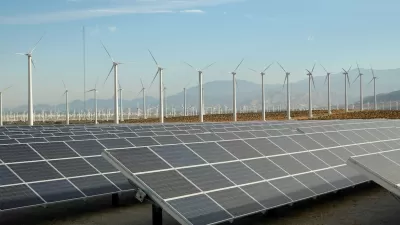Never mind that the lines are needed to carry renewable energy from wind turbines in the north to industries in the south to meet the nation's formidable carbon reduction policies. Public health and property values come first for some neighbors.
Germany set an impressive clean power goal "to reach more than 40 percent renewable power by 2025," writes The New York Times Berlin-based correspondent Melissa Eddy. It's related to another goal—meeting "the accelerated shutdown of Germany’s nuclear plants in the wake of the Fukushima Daiichi disaster in Japan in 2011 which has inched the country back toward a greater reliance on coal," she writes. "Germany already draws nearly a quarter of its annual power from renewable sources."
Instrumental to meeting both goals and reducing reliance on dirty coal power is the construction of "four high-voltage direct current lines" to transmit wind power. Building those lines may be the biggest obstacle to attaining the nation's green goals.
(C)itizens living in the areas proposed for the half-mile-wide transmission lines say they worry that the magnetic fields from the lines could harm their health. (So far, most scientific studies have not found a significant threat. In 2006, the World Health Organization said [PDF] static electric and magnetic fields had no adverse health impact, but public fears persist.)
But it's not just a matter of public health concerns though. As most any affordable home builder in the United States knows all too well, affected homeowners fear a loss in property values.
For the general public, the fear is a little bit irrational,” said Philipp Gerbert, who works for the Boston Consulting Group, which provides information on energy for its clients. “But for those particular individuals actually affected, the presence of a transmission line means the value of their property goes down.”
"The government, in legislation speeding up the lines’ construction, said the public would have a part in the planning process," writes Eddy. Some of main questions the public is asking include:
- Are the lines necessary?
- Can they be undergrounded? [Yes, but too costly for entire lane]
- Can the routing be changed—to other peoples' backyards [hence the NIMBY term], but also to undeveloped, protected lands?
FULL STORY: Germans Balk at Plan for Wind Power Lines

Planetizen Federal Action Tracker
A weekly monitor of how Trump’s orders and actions are impacting planners and planning in America.

Maui's Vacation Rental Debate Turns Ugly
Verbal attacks, misinformation campaigns and fistfights plague a high-stakes debate to convert thousands of vacation rentals into long-term housing.

Restaurant Patios Were a Pandemic Win — Why Were They so Hard to Keep?
Social distancing requirements and changes in travel patterns prompted cities to pilot new uses for street and sidewalk space. Then it got complicated.

In California Battle of Housing vs. Environment, Housing Just Won
A new state law significantly limits the power of CEQA, an environmental review law that served as a powerful tool for blocking new development.

Boulder Eliminates Parking Minimums Citywide
Officials estimate the cost of building a single underground parking space at up to $100,000.

Orange County, Florida Adopts Largest US “Sprawl Repair” Code
The ‘Orange Code’ seeks to rectify decades of sprawl-inducing, car-oriented development.
Urban Design for Planners 1: Software Tools
This six-course series explores essential urban design concepts using open source software and equips planners with the tools they need to participate fully in the urban design process.
Planning for Universal Design
Learn the tools for implementing Universal Design in planning regulations.
Heyer Gruel & Associates PA
JM Goldson LLC
Custer County Colorado
City of Camden Redevelopment Agency
City of Astoria
Transportation Research & Education Center (TREC) at Portland State University
Jefferson Parish Government
Camden Redevelopment Agency
City of Claremont





























